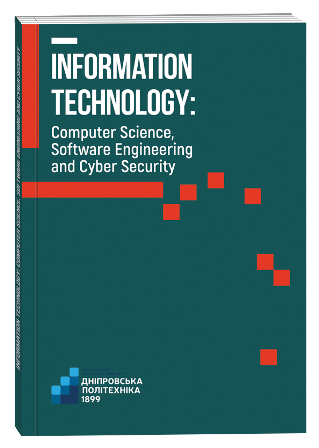DESIGN OF ADAPTIVE DISCRETE MODELS WITH THE APPLICATION OF NEURAL NETWORKS
DOI:
https://doi.org/10.32782/IT/2025-1-13Keywords:
R-functions, discrete model, machine learning, artificial neural network, genetic algorithm, population, fitness-function, crossover, mutation, prediction.Abstract
In modern mechanical engineering, automated design systems have become widespread, building technological processes in more cost and time efficient way, increasing the accuracy of designed processes and processing programs, with the further reduction of material consumption and processing time. The development of new methods and neural network models enables rapid estimation of the required parameters of the state of objects. In practice, machine learning models are used to predict the values of the parameters of the state of structures. Therefore, the application of neural networks, their structural optimization, namely, the selection of the necessary number of layers, activation functions, neurons, etc., currently remains an urgent issue. These activities can be performed both manually, provided that there is a small number of parameters, and automatically. The purpose of the work is to develop an artificial neural network for building adaptive discrete models using a genetic algorithm, which can be applied in aerodynamic structures (airfoil modeling), engineering problems and mechanical engineering. Methodology. This article examines the features of building adaptive discrete models using a genetic algorithm to optimize neural network parameters. An important stage in the implementation of genetic algorithms is the choice of genetic operators: selection, data sampling, crossover, mutation. The definition of these operators impacts on the effectiveness of the method as a whole. The scientific novelty of the research lies in the implementation of new methods and approaches in the construction of geometric models for the automation of design work using neural networks, namely the genetic algorithm. For the implementation of the given research, a model built by means of R-functions in a sequential construction and a genetic algorithm is used, displaying its results in a comparative time characteristic. Conclusions. The study revealed that building an adaptive discrete model using a genetic algorithm provides an accuracy increase and time-efficiency. Therefore, this study can be useful for solving engineering problems, in mechanical engineering, etc.
References
, Abambres M., Marcy M., Doz G. Potential of Neural Networks for Structural Damage Localization. ACI Avances En Ciencias E Ingenierías. 2018. 11, 2, 124–153. DOI: https://doi.org/10.31224/osf.io/rghpf
, Jin C., Jang, S., Sun, X. et. al. Damage Detection of a Highway Bridge under Severe Temperature Changes Using Extended Kalman Filter Trained Neural Network. Journal of Civil Structural Health Monitoring. 2016. 6, 3, 545–560.
, Onur Avci P. O., Abdeljaber A. O. Self-Organizing Maps for Structural Damage Detection: A Novel Unsupervised Vibration-Based Algorithm. Journal of Performance of Constructed Facilities. 2016. 30, 3, 1–11.
, Li K., Liu W., Zhao K., Shao M., Liu L. A Novel Dynamic Weight Neural Network Ensemble Model. International Journal of Distributed Sensor Networks. 2015. 11, Article ID 862056, 13 p. DOI: https://doi.org/10.1155/2015/862056
, Tao S. Deep Neural Network Ensembles. 2019. Retrieved from: https://arxiv.org/abs/1904.05488
, Mengchu Song, Xinxin Zhang, Morten Lind. Automatic identification of maintenance significant items in reliability centered maintenance analysis by using functional modeling and reasoning. Computers & Industrial Engineering. 2023. Volume 182. P. 1–9
, Amorim L., Goveia T., Mesquita R., Baratta I. J. Microwaves. GPU Finite Element Method Computation Strategy Without Mesh Coloring. Optoelectronics and Electromagnetic Applications. 2020. Vol. 19. No. 2. P. 252–264.
Chen Xu, Ba Trung Cao, Yong Yuan, Günther Meschke. Transfer learning based physics-informed neural networks for solving inverse problems in engineering structures under different loading scenarios. Computer Methods in Applied Mechanics and Engineering. 2023. Volume 405.
Bulat A. F., Dyrda V. I., Grebenyuk S. M., Klymenko M. I. Numerical Simulation of Viscoelastic Deformation of Rubber Shock Absorbers Based on the Exponential Law. Strength of Materials. 2022. № 54(5). P. 776–784.
Suchocki C., Jemiolo S. On Finite Element Implementation of Polyconvex Incompressible Hyperelasticity: Theory, Coding and Applications. Int. J. of Computational Methods. 2020. Vol. 17. No 8. 1950049.
Zhou H., Pu J., Chen, Y. Data-driven forward–inverse problems for the variable coefficients Hirota equation using deep learning method. Nonlinear Dyn 111, 2023. 14667–14693. https://doi.org/10.1007/s11071-023-08641-1
Ming Z., Zhenya Y. Data-driven forward and inverse problems for chaotic and hyperchaotic dynamic systems based on two machine learning architectures, Physica D: Nonlinear Phenomena, 2023. Volume 446, 133656, https://doi.org/10.1016/j.physd.2023.133656







